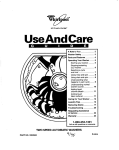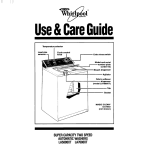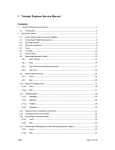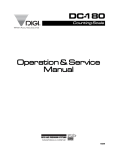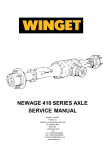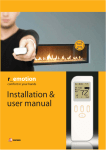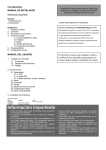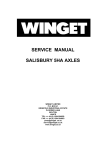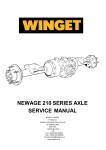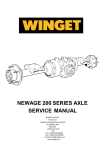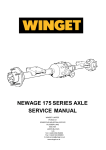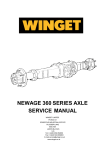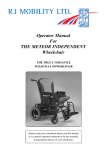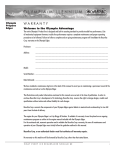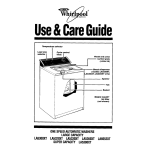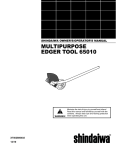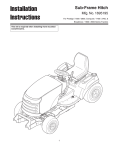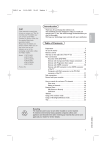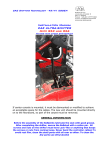Download FACING PAGE SERVICE MANUAL NEWAGE 85M2
Transcript
NEWAGE 85M2S GEARBOX SERVICE MANUAL WINGET LIMITED PO BOX 41 EDGEFOLD INDUSTRIAL ESTATE PLODDER LANE BOLTON LANCS BL4 OLS U.K. Tel:++44(0)1204 854650 Fax:++44(0)1204 854663 E-mail [email protected] www.winget.co.uk Introduction Winget Limited gratefully acknowledge the assistance given by Newage Transmissions Limited in the preparation of this manual, however neither Winget Limited or Newage Transmissions can be held responsible for any errors or ommissions. The procedures described within this manual should enable experienced service personel to strip, repair and re-build Newage 85M2S Gearboxes fitted to Winget 4B and 4S range site dumpers in a safe and competant manner. The procedures are not intended to be used by personnel who are unfamiliar with the product or mechanically inexperienced. It is assumed that personnel are aware of the Health and Safety Regulations which should be applied but the following should act as a reminder. Whenever possible any repairs or service should be carried out in a clean environment. If work must be carried out on site or in the field steps should be taken to ensure that dirt or foreign materials cannot enter the assembly. Ensure all work tools are in good condition and only use the correct tool for the job in hand. Always wear safety spectacles when using soft or hard faced hammers, chisels, drifts or when using air tools. Wear safety spectacles when cleaning components or when grinding. Do not misuse air lines and be aware of the damage compressed air can cause if misused. Always make sure lifting equipment is in good condition and the Safe Working Load exceeds the weight of the component to be lifted. Always use suitable supports i.e. axle stands or baulks of timber in conjuction with hydraulic jacks etc. Never rely on hydraulic jacks alone to support a machine. Be aware of hot surface temperatures and take care when draining hot oils. Always dispose of waste oils in accordance with local and national regulations. Whenever possible always disconnect the battery or battery isolator when working on the machine to prevent electrical shorts and unauthorised starting. Refer to the operators handbook for a guide to the correct sequence for assembling components and sub-assemblies. Oils, fuels, silicone sealer etc can cause skin diseases if allowed to contaminate the skin. Always apply barrier creams, wear suitable protective clothing or when contamination is unavoidable clean the area with soap and water as soon as possible. Do not use thinners or other solvents to clean skin. Health and Safety is a matter of common sense. If common sense is applied correctly the risk of accidents can be reduced. Spares for Newage Gearboxes fitted to Winget Equipment can only be obtained from Winget Limited or one of our authorised distributors and not from Newage Transmissions Limited. Always quote your machines serial number and model together with axle serial number and model when ordering spare parts. 85M2S Gearboxes are designed to operate under arduous conditions and providing they are regularly and correctly maintained they will provide long trouble free service. Whilst every effort is made to ensure the contents of this manual are accurate Winget Limited and Newage Transmissions reserve the right to alter specification without prior notification and certain sections of this manual may then no longer apply. GEARBOX 85M2S Description The gearbox provides three forward and one reverse gear. The gearcase is constructed of heavy duty cast iron for rigidity and strength and the shafts are hardened nickel steel supported by ball and roller bearings. The gear train is of the constant mesh type and shifting is achieved by substantial involute dogs of gear tooth form activated by a robust selector mechanism. The design of the gear train is such that it will accept maximum torque in low gears for long periods. The weight of the basic 85M2S is approximately 34KG. General When overhauling the gearbox cleanliness is important, remove all dirt, cement etc from the outside of the box before any inner parts are exposed. Take care with the dust within the clutch/bell housing as it may contain minute particles of asbestos fibre which should not be blown out with an airline. Damp the dust down and wipe out using damp cloths. Dispose of the cloths safely after use. Use a mandrel press, if available, for pressing out bearings, shafts etc. otherwise use hardwood or non-ferrous metal drifts. Work on a clean suface and wash all parts in clean solvent, lightly oiling before reassembly. If new ball races are to be fitted do not unpack until they are required. Drain the oil before stripping the gearbox. Servicing and Disassembly Remove the bolt through the clutch operating lever and remove the lever from the crossshaft. Undo and remove the cotter through the clutch fork, release the cross-shaft, circlip and remove the cross-shaft, fork, circlip and washer. Undo the six M6 setscrews retaining the oil seal housing/cover within the clutch/bell housing and remove the cover, retrieve the six small nylon washers and gasket. Undo the six M10 setscrews and the two M6 setscrews inside the clutch/bell housing and remove the housing. The upper two M10 setscrews are fitted with nylon sealing washers not spring washers. Remove the hexagon headed dipstick, undo the six M6 setscrews securing the top cover and remove the cover complete with gearlever. The detent spacer, spring and ball for the 2nd/3rd speed selector shaft is retained into the casing by the top cover and these should be removed, it may be necessary to use a magnet to retrieve the detent ball. Using the special tool spread the spring loaded safety interlock and remove from the interlock plate. If the special tool is not available insert the jaws of an open end spanner which is slightly wider than the interlock plate between the safety interlock to prevent it snapping shut and lift out, leave the spanner between the interlock until reassembly. Untab the bolt through the output flange, prevent the flange from turning and slacken the bolt. Remove the bolt, tabwashers, large retaining washer and pull off the flange. The splines of the flange are sealed with silicone sealer which should be cleaned off. Undo the six M10 setscrews and remove the rear cover, the cover is located on dowels and care should be taken when removing. Remove the short spacer off the end of the mainshaft. Remove the grubscrew securing the 2nd/3rd speed selector fork to the shaft, slide out the shaft and remove the fork. The grubscrew is peened over and incorporates a nylon locking insert within the threads and can be exceptionally tight when removing. It is recommended that this grub screw should be discarded after removal and a new screw fitted on reassembly. Remove the split pins through the two clevis pins, pull out the pins and lift out the interlock plate. The rear clevis is a sliding fit in the case and can be pulled free, the front clevis is screwed into the case and should not be removed unless it is damaged or a new case is being fitted. Untab the locknut and remove the locknut and grubscrew securing the 1st/Reverse selector fork to the 1st/Reverse selector shaft. Undo the grubscrew located on the side of the casing adjacent to the selector shaft and remove the detent spring and ball. Slide out the shaft and lift out the fork. As the shaft is slid out of the bore on the rear of the box it will allow the three small detent balls to drop out of the cross drilling in the case between the two selector shafts these balls should be retrieved to prevent their loss. Removal of Gear Set Remove the primary shaft assembly, it may be necessary to lever between the mainshaft and primary shaft or to tap out the primary shaft using a soft drift. Take care not to damage the gear teeth in the process. Withdraw the needle bearing assembly located in the end of the primary shaft. Remove the circlip and press the ball race complete with snap ring off the primary shaft. Align the teeth on the front of the mainshaft so they will pass between the teeth on the 1st speed gear carried by the layshaft and tap the mainshaft out of the box. The gears and spacers are removed from the back end of the mainshaft, one by one, after it has cleared its supporting ball race in the back of the case. From inside the case tap out the ball race complete with snap ring. Remove the two small ball race retaining blocks retaining the larger of the two layshaft ball races. Align the teeth on the layshaft so they will pass the teeth on the reverse pinion and tap the layshaft out of the small ball race until the rear larger ball race is clear of the case. Place two plates approximately 3mm thick between the ball race and case and tap the layshaft back into the gearbox, thus removing the ball race. Alternatively use a suitable bearing puller. Remove the small spacer and reverse layshaft gear via the ball race bore in the case, the layshaft and remaining gears can be withdrawn through the opening in the top of the case. Remove the bearing. The 1st speed gear on the layshaft is a tight fit, remove the 1st speed gear, reverse gear and the 2nd speed sliding gear. The layshaft is now disassembled. Undo the nuts on the reverse idler shaft and remove the retaining washer, gear, thrust washer and needle bearing. Undo the four small setscrews and from inside the case carefully tap out the idler shaft. Check the needle bearing inner race located on the idler shaft. Reassembly Details Clean all parts incuding the interior of gearbox case thoroughly, examine all parts for wear or damage. If the gearbox has been used on continuous heavy duty it is advisable to replace all ball races, needle bearings and oil seals as a matter of course. New oil seals should be fitted by pressing them in with a flat steel plate which covers their entire area, otherwise they may buckle and be spoiled. Output flanges frequently show signs of heavy wear where the oil seal has contacted them. When this condition is observed the flange should be replaced. Splines on the primary shafts which engage with the clutch friction discs are susceptable to wear and distorton, check the splines with a new friction disc, if movement within the splines is excessive or the friction disc will not slide freely on the splines the shaft should be replaced. The shafts and gears are treated with a phosphating process to ensure satisfactory performance. Do not attempt to remove any apparent discolouration by polishing bearing surfaces on shafts or in the bores of gears as seizure may result from the exposure of unprotected steel surfaces. Coat all threads on setscrews etc with threadlock on assembly. Reassembly of Main Gearbox Reverse Idler Tap the reverse idler shaft into the case and refit the four small setscrews and spring washers. Locate the thrustwasher, gear and needle bearing onto the shaft. Fit the retaining washer onto the shaft with the flat uppermost. Secure the locknuts. Layshaft Fit the smaller of the two layshaft support bearings so that it is flush with the outer face of the case. The layshaft should now be partly re-assembled. Fit the inner 1st speed gear and the inference fit 1st speed reducton gear (boss inwards towards the inner 1st speed gear). The inner 1st speed gear must have at least .007" thou end float. Slip on the 2nd speed sliding gear with the collar towards the 1st speed gears. Insert this sub assembly into the case through the top and locate into the small support bearing working the gear teeth past the reverse idler pinion. Through the ball race bore in the back of the case insert the reversing pinion and small spacer. Stand the case on its front face to prevent the small ball race being pushed out of the case as the larger ball race is tapped into place over the layshaft and into the case. Fit the retainers, which should be down tight on the ball race. Spin the layshaft and check all is free. Mainshaft Fit the mainshaft supporting ball race complete with the snap ring into the back face of the case. Pass the mainshaft through the front of the case feeding on the gears in this order:- 1st speed gear (collar inwards), 2nd speed gear, spacer and the output gear (with the narrow boss outwards). They must all be located on their correct shaft diameter as the mainshaft is entered into the supporting ball race. Tap the mainshaft through the ball race in the back face taking care not to dislodge the ball race in the process. Place the gear sets in neutral and turn the mainshaft checking all turns freely. Primary Shaft Fit the primary shaft supporting ball race complete with snap ring over the shaft and tap home. Fit the circlip. Grease the primary shaft needle bearing and carefully fit the primary shaft over the mainshaft taking care to not to damage the needle bearing in the process. Engage each gear inturn, turning the primary shaft and checking all is free. Selector Forks and Shafts Refit the 1st/reverse selector shaft (lower) and the 1st/reverse selector fork, refitting the grubscrew, locking washer and lock nut. Retab the locknut. Replace the three small detent balls into the cross drilling between the selector shafts. Slide the lower shaft forward so the balls are below the level of the bore for the upper shaft. Clean up the “peened” threads in the 2nd/3rd speed selector fork, if the old one is to be reused, using an M8 tap. Refit the 2nd/3rd speed selector fork secure to the shaft using a new special grubscrew. Detents and Interlock Plate Ensure the gearsets are in neutral and refit the 1st/reverse detent ball and spring into the side of the gearbox. Coat the threads of the grubscrew with threadlock and screw into the case until flush. Check the 1st/reverse gear engage correctly, peen the grubscrew and case as a secondary measure to prevent the grubscrew unscrewing. Drop the 2nd/3rd detent ball and spring into the bore above the 2nd/3rd speed selector shaft and fit the short spacer. Using one of the clevis pins and a new split pin, assemble the rear clevis onto the interlock plate. Maintaining the gearsets in neutral, locate the assembly into the gearbox between the selector forks, using the second clevis secure the interlock plate to the front clevis. Before fitting the split pin ensure that the slots in the interlock plate and forks are aligned, if not adjust the position of the interlock plate by screwing the front clevis in or out of the case. Fit the split pin. Locate the spring loaded safety interlock over the interlock plate and slide off the special tool or spanner jaws. Rear Cover Coat the gasket surfaces with a suitable jointing compound, place the gasket over the dowels locate the spacer over the mainshaft. Fit the rear cover, lubricating the oil seal with grease, tap the rear cover over the dowels and tighten the six M8 setscrews. Push the output flange fully onto the mainshaft, run a bead of silicone sealer in to the flange sealing the end of the splines, fit and tighten the retaining washer, lockwasher and bolt. Retab the bolt. Top Cover and Gear Lever Remove the gearlever knob and locknut, untab the steel cover and remove both the steel and rubber covers from the gearlever. Pull the gearlever out from underneath the top cover, remove both pads from the top cover. Pull the retaining plate and spring off the end of the gearlever. Inspect the parts and replace any worn parts. Refit the two pads, push the gearlever back up into the top cover. Refit the rubber and steel protective covers and retab the steel cover, refit the locknut and gear lever knob. Slip the spring over the gearlever and fit the retaining plate. Coat the gasket surfaces with a suitable jointing compound and lay the gasket in place. Refit the top cover assembly ensuring the gear lever engages through the safety interlock into the selector forks, secure the top in place with the six M6 setscrews. Check that each gear is easily obtained. Clutch/Bell Housing Press two new bushes into the housing, coat the mating surface of the housing and gearbox with a suitable jointing compound and secure the housing onto the gearbox uising the six M10 and two M8 setscrews. Fit new nylon sealing washers to the two upper M10 setscrews. Coat the mating surfaces of the clutch/bell housing and seal housing with a suitable jointing compound, lay the gasket in place, lubricate the oil seal with grease and secure the seal housing into place using the six M6 setscrews, fit new nylon sealing washers. With the clutch/bell housing facing you pass the cross-shaft into the housing from the R/H side splines first. Push the cross-shaft through the clutch fork then fit the circlip into the grove cut into the shaft, slip the flat washer onto the shaft upto the circlip. Pass the shaft through the second bush. Fit the cotter pin, nut and washer. Fit the clutch operating lever to the cross-shaft. Top up the oil and refit the dipstick. Tightenting Torques 1/4 UNF Threads 10lbft 13.5NM M6 Threads 9lbft 12.2NM M8 Threads 22lbft 29.8NM M10 Threads 43lbft 58.3NM Output flange bolt 40lbft 54NM Coat the gasket surfaces with a suitable jointing compound and lay the gasket in place. Refit the top cover assembly ensuring the gear lever engages through the safety interlock into the selector forks, secure the top in place with the six M6 setscrews. Check that each gear is easily obtained. Clutch/Bell Housing Press two new bushes into the housing, coat the mating surface of the housing and gearbox with a suitable jointing compound and secure the housing onto the gearbox uising the six M10 and two M8 setscrews. Fit new nylon sealing washers to the two upper M10 setscrews. Coat the mating surfaces of the clutch/bell housing and seal housing with a suitable jointing compound, lay the gasket in place, lubricate the oil seal with grease and secure the seal housing into place using the six M6 setscrews, fit new nylon sealing washers. With the clutch/bell housing facing you pass the cross-shaft into the housing from the R/H side splines first. Push the cross-shaft through the clutch fork then fit the circlip into the grove cut into the shaft, slip the flat washer onto the shaft upto the circlip. Pass the shaft through the second bush. Fit the cotter pin, nut and washer. Fit the clutch operating lever to the cross-shaft. Top up the oil and refit the dipstick. Tightenting Torques 1/4 UNF Threads 10lbft 13.5NM M6 Threads 9lbft 12.2NM M8 Threads 22lbft 29.8NM M10 Threads 43lbft 58.3NM Output flange bolt 40lbft 54NM GEARBOX 85M2S GEARBOX, 85M Description Item No Qty GEARBOX, 85M2S, assembly 1 2 3 4 5 COVER, protective COVER, rubber SPRING PLATE, retaining BALL 1 1 1 1 3 6 7 8 9 BALL, detent SPRING SCREW, grub SCREW, grub 2 2 1 1 11 12 13 14 15 WASHER, locking NUT SHAFT, selector, 1st & reverse PIN, split CLEVIS, interlock plate 1 1 1 2 1 16 17 19 20 PIN, clevis PLATE, interlocking CLEVIS, interlock plate SHAFT, selector, 2nd & 3rd speeds 2 1 1 1 21 22 23 24 25 SEAL, bonded SPACER DIPSTICK COVER, top GASKET 2 1 1 1 1 26 27 28 29 30 WASHER, spring SCREW, set KNOB NUT LEVER, gear select 6 6 1 1 1 31 32 33 34 PAD, gear lever CLIP, bearing retainer SCREW WASHER, flat 2 2 2 2 36 37 38 39 40 BEARING GEAR, reverse SPACER GEAR, 2nd speed SHAFT, lay 1 2 1 1 1 41 42 BEARING, needle roller GEAR, 1st speed 1 1 44 45 46 47 48 GEARCAS BEARING SHAFT, input SCREW, grub BEARING, c/w snap ring 1 1 1 1 1 49 50 51 52 53 CIRCLIP PLUG, oil drain NIPPLE BUSH SHAFT, clutch 1 1 2 2 1 FOR PART NUMBERS REFER TO RELEVANT PARTS MICROFICHE OR OPERATORS HANDBOOK GEARBOX 85M2S GEARBOX, 85M Description Item No Qty GEARBOX, 85M2S, assembly 54 55 56 57 SEAL, oil NUT BOLT LEVER, clutch 1 1 58 HOUSING, clutch 1 59 60 61 61A 62 WASHER, spring SCREW WASHER, spring WASHER SCREW, set 2 2 6 2 6 63 64 65 66 67 WASHER, nylon SCREW, set GASKET, front cover COVER, front, assembly WASHER 6 6 1 1 1 68 69 70 71 72 CIRCLIP PIN, NUT & WASHER assembly FORK, clutch SCREW WASHER, tab 1 1 1 1 1 73 74 75 76 77 SPACER WASHER FLANGE, output SHIELD, dust SEAL, oil 1 1 1 1 1 78 79 80 81 82 BOLT GASKET DOWEL BEARING SPACER 6 1 2 1 1 83 84 END COVER MAINSHAFT 1 1 85 86 87 88 89 90 91 92 93 94 SCREW SHAFT, idler WASHER, thrust RING, inner BEARING, needle PINION, reverse WASHER, idler NUT NUT, locking GEAR 1st speed 4 1 1 1 1 1 1 1 1 1 95 96 97 98 99 100 110 111 GEAR, output SPACER GEAR, 2nd speed NEUTRAL, interlock FORK, selector FORK, selector SCREW, set WASHER, spring FOR PART NUMBERS REFER TO RELEVANT PARTS MICROFICHE OR OPERATORS HANDBOOK 1 1 1 1 1 1 1 8/12 8/12 19 35 55 84 168 294 696 17 30 48 73 146 255 606 5/16 3/8 7/16 1/2 5/8 3/4 1" 515 217 124 62 40 26 829 349 200 100 65 41 23 11 7 14 NOM. MIN. 953 402 230 115 75 47 26 13 MAX. GRADE V 704 297 170 85 55 35 19 10 MIN. 1004 423 243 121 79 50 28 14 NOM. 1155 487 279 140 91 58 32 16 MAX. GRADE X NOM. 10 21 38 59 91 183 319 757 SIZE 1/4 5/16 3/8 7/16 1/2 5/8 3/4 1" 871 367 210 105 68 43 24 12 643 271 156 78 51 32 18 9 1036 437 250 125 81 52 28 14 1191 502 288 144 94 59 33 16 MAX. NOM. MAX. MIN. GRADE V GRADE S 881 371 213 106 69 44 24 12 MIN. 1255 529 303 152 99 63 35 17 NOM. 1443 609 349 174 113 72 40 20 MAX. GRADE X IMPERIAL IN POUNDS-FEET (LBF-FT) COATED THREADS, ZINC & ZINC PASSIVATED 10 8 1/4 MAX. NOM. SIZE GRADE S IMPERIAL IN POUNDS-FEET (LBF-FT) PLAIN THREADS 1067 450 258 129 84 53 29 15 MIN. 853 360 206 103 67 43 23 12 MIN. 24 20 16 12 10 8 6 5 SIZE 24 20 16 12 10 8 6 5 SIZE 770 450 210 96 56 28 11 7 MAX. 570 340 160 72 40 20 8 5 MIN. 920 560 280 115 67 33 14 8 NOM. 1040 640 320 130 77 37 16 9 MAX. GRADE 10.9 800 480 240 100 57 29 12 7 MIN. 1171 677 347 140 80 40 17 10 NOM. 1347 779 399 161 92 47 19 11 MAX. GRADE 12.9 868 502 257 104 59 30 12 7 NOM. 998 577 296 119 68 34 14 8 MAX. GRADE 8.8 737 426 219 88 50 25 10 6 MIN. 1220 706 362 146 84 42 17 10 NOM. 1403 811 416 168 96 48 20 12 MAX. GRADE 10.9 1037 600 307 124 71 36 15 9 MIN. 1464 847 434 175 100 51 21 12 NOM. 1684 974 499 201 115 58 24 14 MAX. GRADE 12.9 METRIC IN NEWTON/METRES (Nm) COATED THREADS, ZINC & ZINC PASSIVATED 694 401 206 83 48 24 10 6 NOM. GRADE 8.8 METRIC IN NEWTON/METRES (Nm) PLAIN THREADS NEWAGE TRANSMISSIONS: TORQUE VALUES FOR FASTENERS WITH CLEAN & DRY THREADS 1244 720 369 149 85 43 18 10 MIN. 995 576 295 119 68 34 14 8 MIN.
















